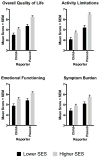Divergent transcriptional profiles in pediatric asthma patients of low and high socioeconomic status
- PMID: 29528197
- PMCID: PMC5992048
- DOI: 10.1002/ppul.23983
Divergent transcriptional profiles in pediatric asthma patients of low and high socioeconomic status
Abstract
Aim: There are marked socioeconomic disparities in pediatric asthma control, but the molecular origins of these disparities are not well understood. To fill this gap, we performed genome-wide expression profiling of monocytes and T-helper cells from pediatric asthma patients of lower and higher socioeconomic status (SES).
Method: Ninety-nine children with asthma participated in a cross-sectional assessment. Out of which 87% were atopic, and most had disease of mild (54%) or moderate (29%) severity. Children were from lower-SES (n = 49; household income <$50 000) or higher-SES (n = 50; household income >$140 000) families. Peripheral blood monocytes and T-helper cells were isolated for genome-wide expression profiling of mRNA.
Results: Lower-SES children had worse asthma quality of life relative to higher-SES children, by both their own and their parents' reports. Although the groups had similar disease severity and potential confounds were controlled, their transcriptional profiles differed notably. The monocytes of lower-SES children showed transcriptional indications of up-regulated anti-microbial and pro-inflammatory activity. The T-helper cells of lower-SES children also had comparatively reduced expression of genes encoding γ-interferon and tumor necrosis factor-α, cytokines that orchestrate Type 1 responses. They also showed up-regulated activity of transcription factors that polarize cells towards Type 2 responses and promote Th17 cell maturation.
Conclusion: Collectively, these patterns implicate pro-inflammatory monocytes and Type 2 cytokine activity as mechanisms contributing to worse asthma control among lower-SES children.
Keywords: asthma; cytokines; health disparities; pediatrics.
© 2018 Wiley Periodicals, Inc.
Figures


Comment in
-
Holistic, personalized, immunology? The effects of socioeconomic status on the transcriptional milieu of immune cells.Pediatr Pulmonol. 2018 Jun;53(6):696-697. doi: 10.1002/ppul.23986. Epub 2018 Apr 17. Pediatr Pulmonol. 2018. PMID: 29667347 No abstract available.
References
-
- Anderson WC, Szefler SJ. New and future strategies to improve asthma control in children. J Allergy Clin Immunol. 2015;136:848–859. - PubMed
-
- Thakur N, Martin M, Castellanos E, Oh SS, Roth LA, Eng C, Brigino-Buenaventura E, Davis A, Meade K, LeNoir MA, Farber HJ, Thyne S, Sen S, Bibbins-Domingo K, Borrell LN, Burchard EG. Socioeconomic status and asthma control in African American youth in SAGE II. J Asthma. 2014;51:720–728. - PMC - PubMed
-
- Castro M, Schechtman KB, Halstead J, Bloomberg G. Risk factors for asthma morbidity and mortality in a large metropolitan city. J Asthma. 2001;38:625–635. - PubMed
Publication types
MeSH terms
Substances
Grants and funding
LinkOut - more resources
Full Text Sources
Other Literature Sources
Medical
Molecular Biology Databases
Miscellaneous

